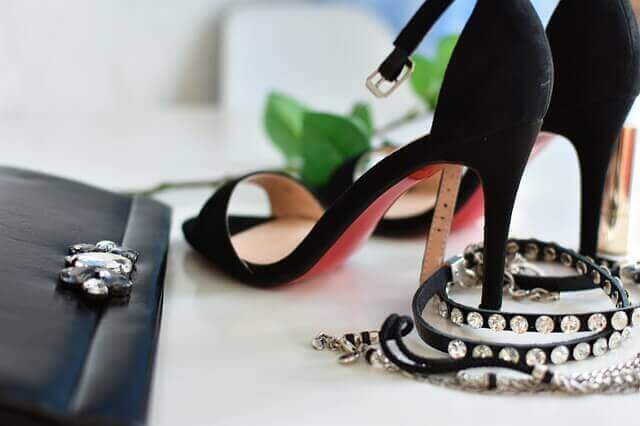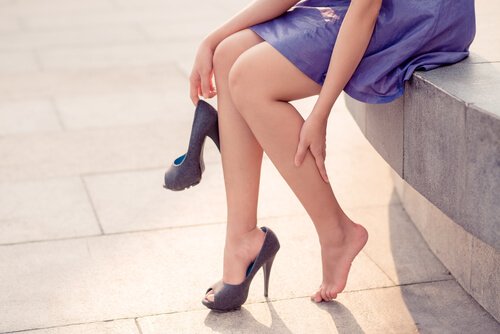10 Tricks for Wearing Heels

There are some tricks for wearing heels for several hours, without suffering. However, this doesn’t mean that it’s advisable to wear this type of footwear on a daily basis or for long periods of time. Therefore, these tricks should be used only when it’s strictly necessary to wear heels for many hours at a time.
Ideally, you should wear comfortable shoes on a daily basis, which allow stability, but also support the feet well and provide enough space for the toes. A pair of shoes that aren’t completely flat, but not too high or at an angle that can cause pain.
Also read: How to Choose the Right Heels for Your Dress
10 Tricks for Wearing Heels and Decreasing Discomfort

When wearing heels, the weight that your feet normally hold is completely shifted. When you increase the height of the heel, the front of your foot must support up to 75% more weight than it’s used to. Because of that, it can cause damage to your foot, knees and even change the alignment of your spine.
Take advantage of these tricks for wearing heels and minimize the adverse effects of wearing heels.
1. Get used to them gradually
It’s not at all advisable to wear high heels for the first time all day long. In fact, you should wear them for short periods of time and, if possible, take breaks. Change positions, sit down, take them off for a while, and so on.
Although they may look nice, shoes with heels of more than 2 inches are the least recommended, especially for those who aren’t used to wearing them.
- When they’re new, it is always advisable to wear them for short periods of time and walk short distances (inside the house).
- If you feel that they bother you in the toe area, the best thing to do is to slightly dampen a newspaper, crumple it into a ball, and put it on the shoes for a couple of nights. This is a trick to “soften” that area a bit to avoid rubbing.
2. Start with wide heels
If you’re not used to wearing high heels and want to start wearing them, or you have a specific event and want to complete your outfit with a pair heals, then you should opt for those with a thick heel.
Shoes that have very thin heels (stiletto) are difficult to bear and even more so for prolonged periods of time. Another option would be to wear platform shoes instead.
3. Take small breaks

With any type of high-heeled footwear, it’s important to take breaks, even for short periods of time. This will prevent your feet from swelling and your legs from feeling like dead weight at the end of the day.
- It may be a good idea to try to massage your feet a little during breaks to reactivate circulation.
- If you’re at home, it’s advisable to take off your shoes and soak your feet for a while in warm saltwater. This will help relieve discomfort and reduce swelling in the area.
- It’s also a good idea to place your feet up for at least 15 minutes a day before going to bed.
4. Wear the right size shoe
Although it seems pretty obvious, we often wear shoes that are too big or too small and these cause us more pain.
If they’re too small, they’ll hurt and can cause blisters. On the other hand, if they’re too big, your foot will slide and this will put more force on the front of your foot since you’re trying to keep the shoe from coming off. Either way, it’s harmful to your feet.
You might like to read: 5 Tips to Prevent Your New Shoes from Hurting You
5. Try to find heels that have an ankle clasp
If there’s an ankle clasp or the insteps are not completely bare, they’ll be a lot easier to adjust. Then, you won’t have to use extra force to keep your foot from coming out, and your feet will take longer to tire out.
- Another trick for wearing heels is to find ones that have a “neckline” in the form of the letter T.
6. Inserts
At the store, you can find small inserts that are placed under two different areas of the foot. Depending on where you are hurting the most, they can be placed under your toes or under your heel.
7. Moisturize your feet
It’s extremely important that you keep your feet hydrated with moisturizing cream so that you can prevent chafing.
- One of the more creative tricks for wearing heels is to put the cream on your shoe and spread it around so that you can soften the material of the shoe.
8. Cool your shoes, one of the best tricks for wearing heels
Inside the shoes, place bags filled with water. Make sure they are tightly closed and don’t leak. Then, take another bag and put the shoes in it. Place the bag in the refrigerator and leave it there for several hours.
As it changes from liquid to solid, the water will put pressure on the shoe and “enlarge” it a little more, which will prevent it from chafing.
In summer, another trick to make shoes a little bigger and softer is to take several sheets of newspaper, crumple them into balls, moisten them with a little water, and put them in the shoes for 24-48 hours. Then, remove the paper balls and leave the shoes to dry in the sun.
9. Platforms
Choosing platforms means choosing shoes that have a thicker sole. This trick will give you the height of the heels without your foot noticing. This attachment will take 1.5 to 2 inches off your heel height, and your feet and legs will feel relieved.
10. Avoid thin soles
Thin soles provide little support for the bottom of your feet. Rubber platforms are better because they absorb pressure when walking and will relieve the pain in the soles of your feet.
Follow these tricks to wear heels and you’ll look splendid without discomfort or pain.
Always remember that continuous use of high heels isn’t recommended. Give priority to comfortable shoes.
All cited sources were thoroughly reviewed by our team to ensure their quality, reliability, currency, and validity. The bibliography of this article was considered reliable and of academic or scientific accuracy.
- Barnish MS, Barnish J, “High-heeled shoes and musculoskeletal injuries: a narrative systematic review”, BMJ Open. 2016 Jan 13;6(1):e010053.
- Spine Health Institute, Florida Hospital: “HOW HIGH HEELS AFFECT YOUR BODY“, s.f.
- Sebastián Valderrama, Patricia Castaño Rivera, Sandra Milena Velásquez, “Revisión sobre la evolución del zapato de tacón según un contexto histórico y su efecto en la salud de sus usuarios”, ICONOFACTO VOL. 13 Nº 20 / PÁGINAS 160 – 177
This text is provided for informational purposes only and does not replace consultation with a professional. If in doubt, consult your specialist.








